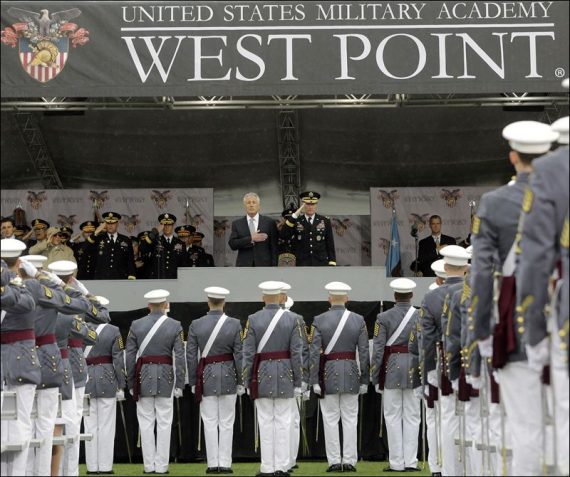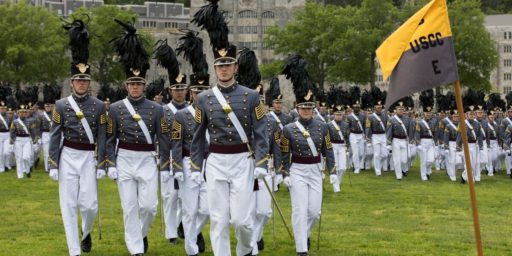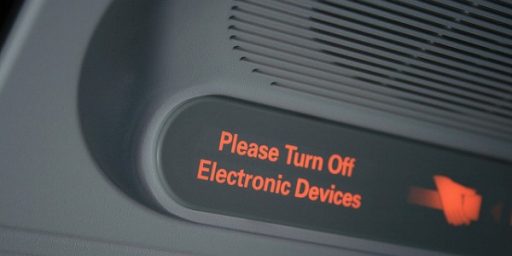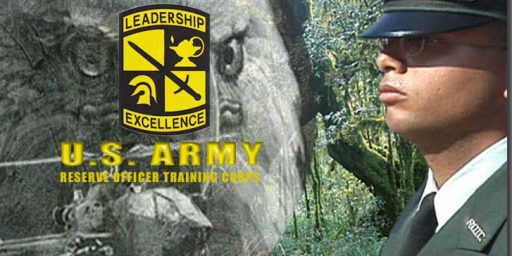West Point Casualties in Post-9/11 Conflicts Historically High
West Point graduates account for nearly one in fifty deaths in the wars in Iraq and Afghanistan.
West Point graduates account for nearly one in fifty deaths in the wars in Iraq and Afghanistan.
Army Times (“West Point Combat Casualties Are High In Post-9/11 Era“):
West Point graduates have accounted for a higher percentage of U.S. military combat deaths in the post-9/11 war on terrorism than in all but one major American conflict since the academy’s founding in 1802.
As of Monday, 5,293 American troops have been killed in action in operations Iraqi Freedom, New Dawn and Enduring Freedom, according to Defense Department data. Ninety-four casualties, about 1.8 percent, have been former cadets, an academy spokeswoman said.
[…]
The cadet-death ratio in the Iraq and Afghanistan conflicts is nearly seven times greater than in the War of 1812, in which 0.3 percent of the total combat deaths were West Point grads; 42 times greater than among Union forces during the Civil War; nearly 11 times greater than in World War II; nearly four times greater than during the Korean War; more than three times greater than in the Vietnam War; and nearly three times greater than during the Persian Gulf War, where the percentage was 0.7 percent. That data is from the Naval History and Heritage Command.
The only major conflict on the other side of the ledger is the Mexican War, which ended in 1848 after claiming former cadets at a proportional rate 56 percent higher than during the war on terrorism.
Mostly, this a function of the changing nature of conflict and shape of the force.
“Those other wars were fought by mass armies with many officers who were citizen-soldiers, not military professionals,” said USMA history professor Dr. Clifford Rogers in an email. “So the West Point presence was more ‘diluted.’ ”
Other historians credit a decreasing ROTC presence within the officer corps for the rising percentage of combat casualties represented by former cadets.
“West Point is just a larger portion of the officer corps than it’s been in the course of the 20th Century,” said West Point history professor Dr. Samuel Watson. “The gap between the growth in Officer Candidate School and decline of ROTC has been felt by West Pointers. Anything else would be coincidental.”
Fully 80 percent of male USMA graduates, who become second lieutenants upon graduation, must go into combat arms, Watson added. Candidate school and ROTC graduates, on the other hand, may choose either infantry or another career path within the Army.
The war on terrorism has been characterized by counterinsurgency, a warfare tactic that has put more pressure on junior officers in general, Crane said.
“COIN is a small-unit fight — not big units,” said [retired Army Colonel Conrad] Crane, who graduated from West Point in 1974. “Whether you win or lose depends on how much risk the junior leaders and people at the point of spear are willing to take.”
That 94 West Pointers have died in wars with such relatively low casualties is somewhat astounding. Until you look at the baselines.







I know it is not intended, but the piece smacks of “important people are dying in the wars too, not just peon Privates”. As the father of an NCO and a low-ranked airman, it stings a little.
@Tony W: My dad retired as a First Sergeant and was a Sergeant and Staff Sergeant in Vietnam. I just see this as an interesting factoid about changing nature of service.
@Tony W:
This article is just a factoid. As such, it serves as an effective Rorschach test. If somebody hates West Pointers, they’ll say the statistic is due to ‘Pointers making stupid tactical errors or being complacent. If you like West Pointers, you could say that the statistic is due to ‘Pointers leading from the front, which is a dangerous endeavor.
Instead, you (out of left field) take it as an insult to your relatives, who (in your chosen words) are “peon privates”. This says little about the article, and a lot about how you feel about your family. Perhaps the sting is not from the article, but from your shame that your family (in your eyes) didn’t choose to “be more”, from your point of view, Hmm?
The bottom line is, the loss of any American servicemember, at any rank, is the loss of a national family member. I thank your kin for their service, too, and I don’t hold their NCO or “low rank” status against them.
-Your friendly psychologist.
@Tony W:
Oh, it’s more than that. Note the quote from the USMA history professor about “citizen-soldiers” and “military professionals”. Apparently, you can’t be a military professional unless you are a rink knocker. I expect that would be a surprise to your NCO and his ilk or the many “amateur” officers who came in via ROTC or OCS, not to mention those who came up the hard way.
The good news is there is a logical numbers explanation for the increase versus it being due to the new, kinder, gentler, sensitive USMA.
It should also be noted that the corps of cadets increased dramatically in the mid-1960s.
Mr. Joiner,
You wrote, “Candidate school and ROTC graduates, on the other hand, may choose either infantry or another career path within the Army.”
That was not my son’s experience when he graduated from Texas A&M. All of the ROTC cadets could select three service options. My son wrote down, “Armor, Infantry, and Engineering.” The Army selected “Field Artillery.” It seems like the Army makes the real choices. While in Iraq, he was a counter insurgency officer (funny, that wasn’t one of the choices).
@JKB: No. He’s referencing the fact that we used to build armies almost from scratch when wars started, with even the officers having been civilians prior to the war. For the last sixty years, though, we’ve maintained a large, standing force and all our officers are either career professionals or reservists/guardsmen who spend significant time training for military duty.
@Steve: I didn’t write that; the Stars and Stripes reporter I was quoting did. Officers from both USMA and ROTC can go into most any accession branch, but by statute most West Point officers have to go into the combat arms.
Do you have any numbers on this? I can’t find any data on the percentage of officers that come from the academies vs. ROTC. Although the “decline of ROTC” part is so laughably wrong, I doubt he’s right about the mix as well. Far from declining, ROTC has grown rapidly since 9/11 and is producing far more officers than it has at any time in history.
I think some more numbers would have shed more light on this topic with fewer concerns on your intended meaning.
Some quick questions off the top of my head:
How does this compare to the % of KIA Officers from other commissioning sources in these wars?
What percentage of the Officer Corps is made up of West Point Graduates? Then, what % of West point graduates account for Officer KIAs post 9/11?
I see the point you are trying to make. I also understand the perspectives of those people who saw something else in the article.
-Matt
@Stormy Dragon:
That is from wikipedia so finding numbers is not hard if you actually look. Here is the link for the raw data http://prhome.defense.gov/rfm/mpp/ACCESSION%20POLICY/PopRep2010/appendixb/b_30.html
So 70% of all active duty officers are non-ROTC. As far as if that is a increase or decrease over the past, I will take the word of the West Point history professor over the random guy making comments in a blog. It is up to you to find the numbers that dispute this and if it is true, it wont be hard to do.
@jib10:
But then we have the US Army Cadet Command:
Even from your own source suggests that ROTC (21.5% of comissions) provides far more officers than the academies (17.2% of comissions).
Also, one year of statistics don’t establish a trend. According to the news, ROTC enrollment is growing rather than declining:
So maybe Dr. Watson, who is after all a history professor and not a recruiter, is just a bit to rah rah for his current institution and doesn’t actually know what he’s talking about.
@JKB: As defined by us at West Point a military professional is anyone that is in the modern military. The wars he is referring to were when you could buy your commissions from the government and go “play” soldier in your free time, such as with the Civil War and even up to WWII to a certain extent. If you are a member of the current modern military you are considered to be a military professional.
@Stormy Dragon: Many ROTC cadets to not go into the active military with most of the combat arms slots going to West Point.
@Mike
Do you have any numbers on that? I’m guessing here but I think your “many” is probably less than 20% and your “most” is probably less than half of the total combat arms slots of commissioned officers per year. but again, I don’t have facts so I’m not going to make those bold statements.
Any Officer worth is salt, regardless of commissioning source, understands that he is not above the danger and is willing to subject himself to the same hardships and risks as his men. That is leadership in its most pure form. Nathan Fick in his book “One Bullet Away: the Making of a Marine Officer” said it best: “I had to be willing to sit down with someone’s family, father, or spouse and tell them honestly why their father, son, or husband had died working for me and why I thought it had been worth it. And the answer had better now have been because they weren’t trained or prepared, the planning incompetent, or the resources lacking. That sets the bar tremendously high– but we cleared it every day”.
I knew many of those 94 names personally during my time as a cadet. I know many more of the 5,293 names. I can think of no greater privilege then having known people of that resolve, loyalty and dedication. During my time as a platoon leader my NCOs and soldiers worked extremely hard for me and it would tear my heart out to see any of them killed or maimed. Just as it tears my heart out to see my West Point classmates fall in the line of duty. But we knew the risks and willingly accept that burden, because the people under us and to the left and right of us, depend on it. That is something that almost every cadet, and especially the ones who volunteered to go combat arms, should have embodied since day 1.
Statistics aside, when you step in front of your unit, having invested the blood, sweat, and tears necessary to earn their trust and confidence– it is one of the most inspiring and humbling experiences I have ever witnessed. It is a tremendous responsibility that neither my peers or I take lightly.
Well done. Be thou at Peace.
Ty Stephens
West Point Class of 2011
@James Joyner: I think something to consider with this data is the size of west point compared to the size of the fighting force. The number of soldiers during world war two was extremely high while west point was only slightly smaller than it is today. when the force shrank and the size of a wets point graduating class has grown, the number of west point deaths per total soldier deaths will statistically increase.
Duty,Honor, Country. 5% of my Class of ’66 was killed or wounded in the 2 years following graduation. Every last one of us honors our loss and all of this Service we willingly have given to our Republic, despite the hatred, vicious abuse and public humiliation to which we were subjected in the subsequent years, right up to the career officers’ retirements. NOW, it is your choice to honor the returning veterans of Iraq & Afghanistan and insure they receive their benefits and the respect they deserve.